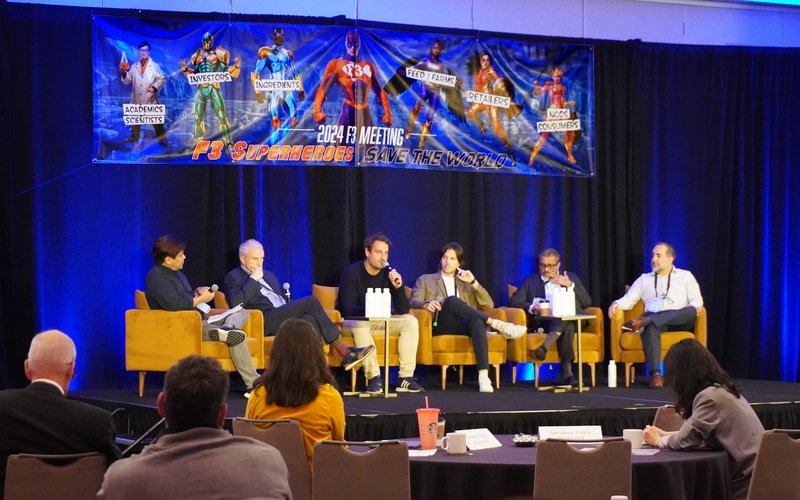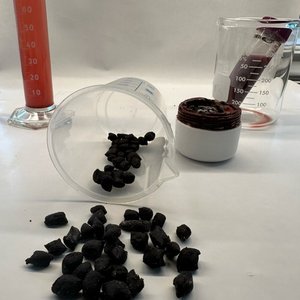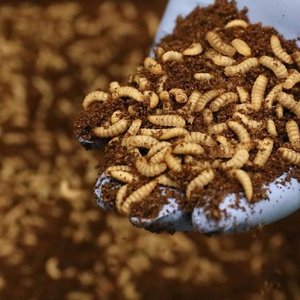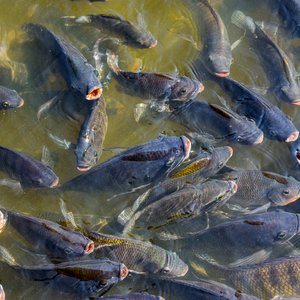In the 1990s, about 80% of the fish feed was marine-based. Today, it has decreased to an average of 20% of marine ingredients with the rest being mainly vegetable raw materials. In the coming years, novel ingredients, such as single-cells and insect meal, will be key.
Marine ingredients are being used more as strategic ingredients but there is a demand for other protein and oil sources. The so-called “alternative” or novel ingredients, such as insect meal, single-call proteins (SCPs), etc., are expected to fill that gap but it takes time and investment to scale up and reach the volumes the industry demands. Despite feed companies willing to increase their use, their incorporation has been small: Skretting reported 1% of novel ingredients in its 2022 feeds and Cargill reported 5.3% in its cold water feeds in 2023.
The Future of Fish Feed (F3) is a collaborative effort between NGOs, researchers, and private partnerships to accelerate the commercialization of innovative, substitute aquafeed ingredients to replace wild-caught fish. F3’s biannual meeting took place in May in San Francisco where industry leaders, including aquaculture investors, discussed the recent advances and bottlenecks in scaling up these novel ingredients.
Why is it taking so much time for these novel ingredients to scale up?
“Innovation is great, but if it never reaches the market, if we can't have that scale, a lot of those efforts will just die on the buying,” said Ron Shigeta, principal at iAccelerate.
“Every new feed ingredient company gets to a stage where they have to build their first commercial pilot. That is usually still technologically not a de-risk phase, but it is usually too large a ticket for venture capital (VCs) like us to participate,” said Carsten Krome, managing partner at Hatch-Blue.
“I see a gap in funds available for companies building their first commercial pilot. Typically, it's between USD 10-40 million that needs to be raised. Companies usually try to combine grants, soft loans, and some equity, but it is not ideal. Funding ingredient companies with their first commercial pilot with a venture debt type of structure would have made the industry move further if that sort of funding structure had been available some time ago,” Krome stated.
“There's been a lot of over-promising in the sector. Early investors have been over-promised kind of timelines, unit economics and all that. Many of these CEOs actually knew that would never happen and that is backfiring on them right now because some of these stakeholders are walking away,” said Tom Prins, head of dealflow at Aqua-Spark.
“We are guilty in this industry of often being in our own echo chamber. There is such a great, sexy story to tell about the promise of all these sectors of aquaculture combined with investors that buy into that and often that capital is put into projects that were not properly de-risked,” said Max Holtzman, principal and portfolio governance, Ocean 14 Capital.
“The aquaculture industry needs to get better at communicating some of the positive attributes of the industry, but also at actually communicating about the problems. If you are an investor, if you are an innovator and you are getting started in this industry, it is really hard to get an actual grip on the actual problems in the market because it's not talked about enough,” Prins said.
But this is not only an engineering exercise, it is also about managing people. “A lot of the companies in the market have gone wrong in managing people and attracting the right talent to make it happen. At the end of the day, we're still investing in people’s business and we've seen companies having huge challenges attracting the right people to execute and manage a variety of stakeholders involved to get through the scale-up phase,” Prins stated.
Investors also suggested that other types of investments, such as genetics, with potential impacts in the aquafeed industry, should be considered. “We have been doing some back-of-the-envelope calculations in species like carp and catfish and using just selective breeding, we could reduce the FCR by 10-15% which in ten years with a 25% market penetration of these better genetics would lead to 800,000 tons of feed saved. That's a huge amount of feed,” Prins said.
Insect meal as an example
Insect meal is one of those novel ingredients that haven’t reached the expected scale levels yet. “The insect meal industry has cost as a main challenge. Customers are not able or willing to pass on a premium to end consumers. Therefore, we have to compete at price levels that are competitive to fishmeal and that's a challenge,” said Marcel Smits, director, Entobel.
What are the solutions? Reducing costs such as operating in Vietnam as Entobel is doing with cheaper labor (10% lower than in Europe) and warmer temperatures, or increasing prices due to consumer demand for fish-free fish or the functional benefits of insect meal.
However, increasing the scale will help even more. Entobel has built a 1,000-ton plant with a production capacity of 500-600 tons per year. Now they have built a 10,000-ton plant. “If you go from 1,000 tons to 10,000 tons, the economics start to work better,” Smits said.
The insect industry is very capital-intensive. Entobel’s 10,000-ton plant has an investment of USD 25-30 million and is expected to generate about USD 25-30 million in revenue. That means a Capex revenue ratio of one. “Building a greenfield factory, the economics of scale starts to taper off at 15,000 to 20,000 tons. However, even at that scale, we still have work to do, either in selective breeding or in the optimization of feed-to-product conversion,” Smits said. “Fifty years ago, it took 113 days to raise a chicken. Nowadays, that's down to 46. The feed conversion ratio was 4 and nowadays around 2. The insect meal industry needs to do that in three years rather than 50. If you can get that kind of impact in the insect meal industry, the economics will start to work.”
After scale, the next big bottleneck is expected to be feedstock. “For Entobel, currently, the feedstock is mainly coming from Heineken’s spent grain. But if we want to get to 100 plants, we need different feedstock. The use of byproducts from the palm industry in Indonesia is the expected next step because the palm industry has byproducts and volume that is almost unlimited,” Smits concluded.










